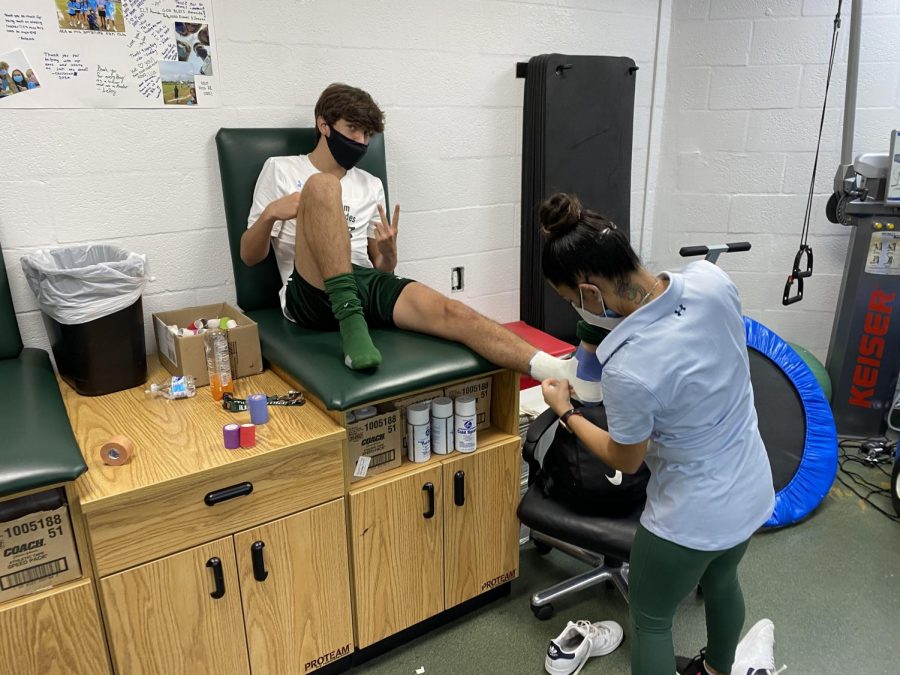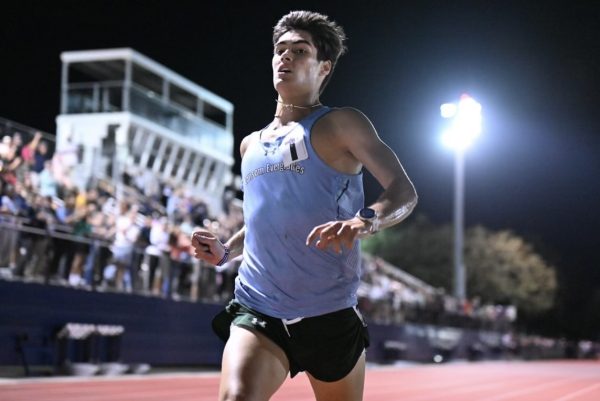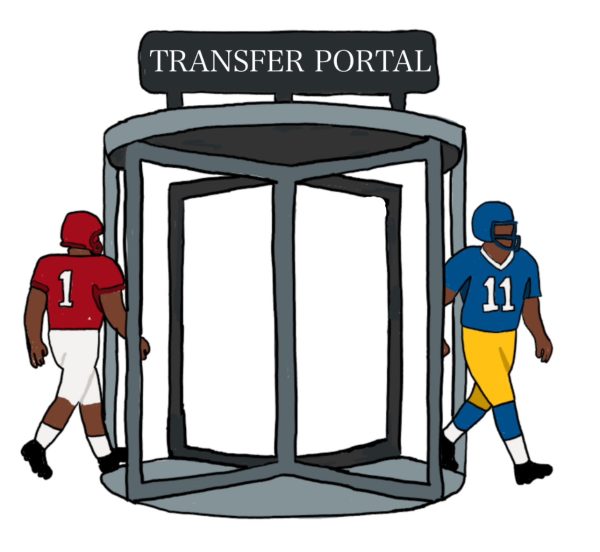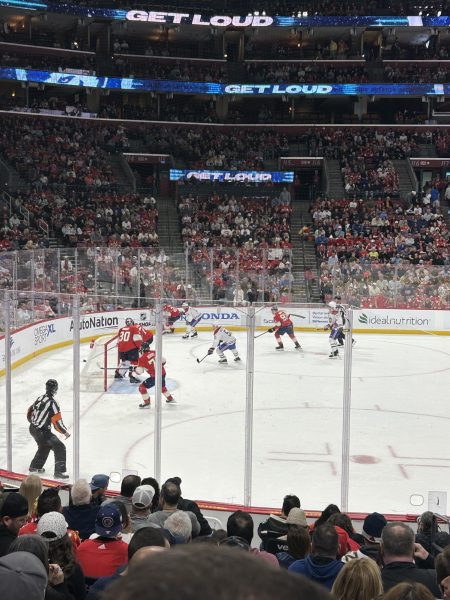Subluxations, dislocations, and more: Inside RE’s new Sports Medicine course
Ms. Zamani treats an RE athlete.
This year, the Ransom Everglades Athletics Department is offering a new course, “Intro to Sports Medicine,” taught by Amanda Zamani, RE’s head athletic trainer. This semester-long course combines anatomical and kinesiological concepts to expose students to the realm of sports medicine, and it filled up for both semesters after the course selection process last spring.
The course is open to sophomores, juniors, and seniors, which helps fulfill the P.E. credit requirement for all students after their freshman year. In addition to learning how to deal with athletic emergencies and treat sports-related injuries, students obtain a First Aid AED certification from the American Red Cross.
However, the highlight of Sports Med, as it is frequently referred to by students, is the clinical hours, as students experience how it feels to be an athletic trainer in action. While the training room is their seventh period classroom, the field and the gym are their laboratories.
Zamani, now in her second year at Ransom Everglades, had always yearned for the opportunity to teach her passion in a classroom setting. She began conversations about creating this class with Coach Goff, RE’s Director of Athletics, during her interview process. In 2019, she arrived at Ransom Everglades from the Harvard-Westlake School in Los Angeles.
Goff and Zamani searched for creative ways to introduce new ideas to the Physical Education curriculum. Zamani sought to “have an environment where people who don’t necessarily play sports can be involved in athletics while also teaching the kids that are involved in sports lifelong ways to treat and care for their bodies.”
While the class contains some current Ransom Everglades student-athletes, Zamani hopes that “more non-athletes would take it to be involved in athletics and to see how much work a student-athlete puts into it,” further expanding the Ransom Everglades Athletics community.
Ransom Everglades students were just as eager to embark on a new journey this year for a variety of reasons.
“I am interested in going to med school, so I felt that this was an incredible class I could take to fulfill my last P.E. credit,” Amanda Sotolongo ’21 said. Her classmate, Claire Holzman ’21, sought “a new understanding of the muscles you use in athletics and the human body in general.”
Students assume an active role in the process of absorbing these topics. Sotolongo found videos on YouTube to help her understand the difference between a dislocation and a subluxation, and she enjoyed watching these dislocations taking place. “I don’t think that’s the popular opinion, but I thought it was cool,” she said. “It’s also nice when [the joint] pops back into place.”
The students cultivate their interests in medicine and sports by accumulating at least 20 hours of clinical work over the course of the semester. They spend afternoons or free periods preparing practices, covering games, and treating injured athletes with Coach Zamani. Although these novice athletic trainers are sometimes limited in their roles, working clinical hours is still a rewarding experience for them.
“Once I’m doing it, I find questions that I wouldn’t have known I had, so I learn more from these tasks,” Sotolongo said.
In such a hands-on class where small details make a difference in an athlete’s recovery, remote learning presented several obstacles. The first week of this semester was conducted remotely, and some students continue to take this class through Google Meet while their peers learn from the training room.
“I was able to listen to the new lessons along with the other students,” Sotolongo said. “But once everyone started applying the knowledge to real examples, [being remote] was hard. All the in-person students practiced taping ankles and wrists, but I could only watch.”
“Remote learning was brutal,” Zamani said. “It’s definitely different to teach them in person where they can see the chaos that athletes experience now.”
“[Remote learning] wasn’t as exciting as it is in person,” added Sotolongo.
“I’ve been very pleased with how Ms. Zamani and the students have handled [remote learning],” Coach Goff noted. “I think it has been a very positive experience.”
When learning to tape ankles and wrists, the students must practice on each other so that they feel confident and prepared whenever an athlete walks in. For Holzman, “being able to actually visualize [these concepts in person] makes the world of difference.”
Coach Goff and Coach Zamani both see the potential of this course to act as a platform for studies in college and beyond. While Sotolongo and Holzman both plan on exploring other scientific fields, Zamani hopes that eventually, her class will inspire students to pursue degrees and careers in the field of sports medicine.
“That would be my dream,” Zamani said. “I would also love for the class to be more than one semester so that they can learn even more.”
“Given the interest that we’ve had, our hope is at some point to collaborate with the science department and create a course that would be worthy of academic credit,” Goff said.
The sports medicine program strives to keep all Ransom Everglades athletes healthy and safe, and Coach Zamani is available throughout the day for athletes. Goff deems this a massive advantage for our school, as “when our student-athletes are healthy, our programs are healthier, and that has a significant impact on the results of our programs…The work that’s being done in physical therapy clinics or in doctors’ offices is often being done right here in our athletic training room.”
“If I wasn’t heating before practice and icing after practice, I’m not sure I’d be able to play at the level I’m playing right now,” dual-sport athlete Thomas Schein ’21 said. “The training room has allowed RE athletes to [recover quickly], and I hope the athletics department can continue to improve on it in the future.”
Coach Zamani works closely with the strength and conditioning staff, Coach Victoria Dreuhl and Coach Jake Caron, to monitor athletes’ workloads throughout the year in order to help prevent injuries. “Now we have several experts here on campus who can make sure that our student-athletes can conveniently get the treatment that they need and get back on the field as quickly as possible,” Coach Goff said.
Despite the challenges of starting a new course and learning properly amid the pandemic, “Intro to Sports Medicine” has exceeded students’ expectations for its first year. Sotolongo enjoys how Zamani “gets really excited to teach us. That’s always super helpful because it makes me more engaged. You can tell that she really loves what she does.”
“This is the only class I take where I can apply what I learn in the classroom to real-world experiences directly after I learn them,” Holzman added.
“We definitely were interested in creating a course that would draw interest from people beyond just the athletes,” Coach Goff said, reflecting on the success of the course. “And that’s been the case so far.”
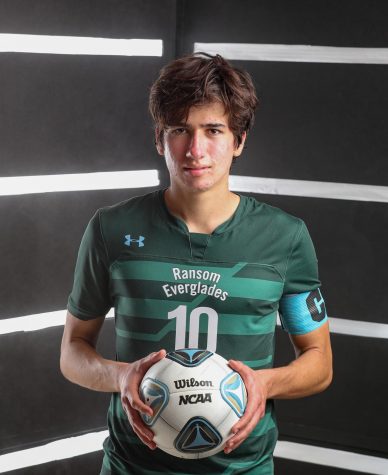
Nicolas Stone Perez '21 is a staff writer and copy editor for The Catalyst.


